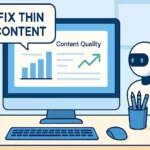Amazon Affiliate Compliance: What You Must Know in 2025

Introduction
Amazon affiliate compliance in 2025 is more critical than ever for anyone using the Amazon Associates Program. With millions of creators earning commissions by promoting Amazon products, staying compliant with the latest rules has become essential—not optional.
Whether you’re a seasoned affiliate marketer or just starting your journey, understanding and following Amazon’s updated compliance policies is the key to long-term success. In this comprehensive guide, you’ll learn the most important Amazon affiliate compliance requirements for 2025, plus practical strategies to protect your account and maximize your earnings.
To succeed as an affiliate in 2025, make sure you’ve also read our Complete Beginner’s Guide to Starting a Blog and Making Money in 2025, which lays the foundation for long-term success.
Understanding Amazon Affiliate Compliance in 2025
The Stakes Have Never Been Higher
Amazon has significantly tightened its compliance enforcement in 2025, with automated systems that can detect violations more efficiently than ever before. The company reported suspending over 50,000 affiliate accounts in the past year alone, with disclosure violations being the primary reason.
According to John Harrison, Affiliate Marketing Specialist at Authority Hacker: “Amazon’s zero-tolerance approach to compliance violations means affiliates need to be more diligent than ever. The days of skating by with minimal compliance are long gone.”
Amazon Affiliate Compliance Requirements for 2025

1. Amazon Affiliate Disclosure Requirements in 2025
Proper disclosure of your affiliate relationship with Amazon isn’t just an Amazon requirement—it’s also mandated by the Federal Trade Commission (FTC) and similar regulatory bodies worldwide.
To ensure legal compliance in the U.S., review the FTC’s official disclosure guidelines for affiliates.
What Has Changed in 2025:
- Disclosures must now appear above the fold on every page containing affiliate links
- Generic disclosures are no longer sufficient; they must specifically mention “Amazon” and “commission”
- Mobile-specific disclosure requirements have been introduced
For more insights on optimizing user behavior and email compliance, read our guide on How to Increase Email Open Rates by 37%.
How to Implement Proper Disclosures:
| Placement | Required Content | Example |
|---|---|---|
| Above the fold | Explicit mention of Amazon + commission | “As an Amazon Associate I earn from qualifying purchases.” |
| Near affiliate links | Clear indication of affiliate relationship | “This is an affiliate link. I earn a commission if you purchase through it.” |
| Product review pages | Prominent disclosure at top of page | “This review contains Amazon affiliate links. If you purchase through these links, I earn a commission at no extra cost to you.” |
Amazon now requires the specific disclosure text: “As an Amazon Associate I earn from qualifying purchases” to appear on every page of your site that contains affiliate links. This must be visible without scrolling.
2. Affiliate Link Rules: No Cloaking or Shortening
Amazon maintains strict rules about how you can and cannot use their affiliate links.
Current Requirements:
- No link cloaking or masking the destination URL
- Limited use of link shorteners (only approved services)
- No automatic link insertion without context
- Links must lead directly to Amazon products, not intermediary pages
Best Practices for Link Compliance:
✅ DO: Use the SiteStripe tool to generate compliant links
✅ DO: Ensure all links have the proper tracking ID
✅ DO: Use descriptive anchor text for your links
❌ DON'T: Use JavaScript to hide affiliate parameters
❌ DON'T: Cloak links or use unauthorized shorteners
❌ DON'T: Insert affiliate links into emails without explicit permission
3. Product Data Compliance & API Integration for Amazon Affiliates
Amazon requires that all product information displayed on your site be accurate and up-to-date.
Key Requirements:
- Prices must be displayed as “current” or with a timestamp
- Product availability must be accurate
- Reviews and ratings must be current or timestamped
- API usage must follow Amazon’s Product Advertising API License Agreement
Implementing API Compliance:
Most successful affiliates use Amazon’s Product Advertising API (PA API) to ensure data accuracy. In 2025, Amazon requires all sites with more than 100 product listings to use the API rather than manual updates.
Learn more in the official Amazon Product Advertising API documentation.
“The biggest mistake I see affiliates make is displaying outdated pricing information,” says Sarah Johnson, Amazon Compliance Consultant. “That’s a fast track to account suspension.”
To learn how top affiliates automate their sites and save hours every week, explore our Ultimate Guide to Amazon Affiliate Site Tools.
4. Content Guidelines: Image and Text Usage
Updated 2025 Requirements:
- Limited use of Amazon product images (maximum of 3 per product)
- No modification of product images except for resizing
- No copying of product descriptions verbatim
- Must include qualifying language for subjective claims about products
Content Compliance Checklist:
- [ ] Limit Amazon product images to 3 per product
- [ ] Do not alter images beyond resizing
- [ ] Write original product descriptions
- [ ] Include “as of [date]” with any price mention
- [ ] Add qualifying language for subjective claims (e.g., “In my experience…”)
If you want to go beyond compliance and build a niche site from scratch, check out our in-depth blueprint: Mastering Amazon Affiliate Niche Sites (2025 Edition).
5. Prohibited Content for Amazon Affiliate Compliance in 2025
Amazon has expanded its list of prohibited content categories in 2025:
- Adult-oriented products without proper age verification
- Cryptocurrency-related products without disclaimers
- Health claims without FDA approval references
- Gambling-related content without proper disclaimers
- Political content that could be divisive
Amazon Affiliate Compliance 2025: Local Market Adaptations
While Amazon’s global affiliate program follows core compliance principles, regional laws may impose additional requirements. Here’s how to ensure compliance in key markets:
European Union (EU) & UK
- GDPR (General Data Protection Regulation): Disclosures must be explicit and avoid pre-checked consent boxes. Understand how cookies and personal data impact affiliate compliance under GDPR and the ePrivacy Directive.
- ePrivacy Directive (2002/58/EC): Prior consent is required for all non-essential cookies, as outlined in Article 5(3) of the directive. This is often informally called the “EU Cookie Law”, but is distinct from GDPR’s personal data regulations.
- Consumer Rights Directive: Prices must include all mandatory charges (e.g., VAT), and refund policies must be clearly presented.
- UK CMA Guidelines (2024): Disclosures like “This is an affiliate link” must be immediately visible near links. See official CMA guidance for influencers:
- Use
#ador#affiliatein social posts - Disclose before the “Read More” break
- Avoid vague terms like “collab” or “partnered”
- Use
Canada
- Competition Act: Disclosures must be “clear and conspicuous” (e.g., “We earn a commission from Amazon.ca links”).
- Provincial Laws: Québec mandates French-language disclosures for French-speaking audiences.
Australia & New Zealand
- ACCC Rules: Phrases like “We may earn a fee” must accompany affiliate links.
- Fair Trading Act (NZ): Prohibits misleading “limited-time” or “was/now” discounts without documented price history.
Germany
- Telemedia Act (TMG): Requires affiliate disclosures in German (e.g., “Wir erhalten Provision von Amazon”).
- Price Indication Ordinance (§ 1 PAngV):
- All prices must include 19% VAT
- Unit pricing is required for multi-item or bulk goods
- Use of “free” for Prime benefits must be accurate and provable
France
- French Consumer Code: Requires that disclosures be in French and that product prices display TTC (toutes taxes comprises).
- Refund rights and return links must be clearly stated (e.g., amazon.fr/returns).
Brazil
- Consumer Defense Code (Código de Defesa do Consumidor – CDC), Article 49:
- Old prices must be visible for at least 30 days prior to discount
- New price must be valid and available for at least 90% of customers
- Violations can result in fines up to R$13 million (Brazilian Ministry of Justice)
Japan & Southeast Asia
- Act on Specified Commercial Transactions (特定商取引法), Article 12:
- Disclosures must appear above product features (fold area)
- Disclosure text size must be at least 10.5pt
- Seller information (e.g., Amazon Japan G.K.) must be clearly listed
- 8-day cooling-off period must be disclosed where required
- Singapore’s Consumer Protection Rules: Prohibit unverified claims like “miracle” or “guaranteed” for health-related products unless approved by HSA.
Actionable Local Compliance Steps for Amazon Affiliates:
- Implement region-specific disclosures (e.g., change “Amazon UK Associate” for UK visitors).
- Use geo-targeting tools (e.g., AAWP or Geniuslink) to serve localized product links.
- Conduct quarterly legal reviews based on target region laws.
- Consider legal consultation if targeting highly regulated countries like Germany or Japan.
Pro Tip: Amazon’s OneLink helps with geo-redirects but does not manage compliance disclosures. Always add manual legal disclosures per region.
Legal Disclaimer
This article provides general information only, not legal advice. Amazon’s policies and regional laws change frequently. Always consult a qualified attorney in your country for compliance verification. Sample disclosures may require legal adaptation.
Amazon Affiliate Compliance: Implementation Strategy for 2025
Step 1: Conduct a Comprehensive Site Audit
Begin by auditing your existing content for compliance issues:
- Check all pages with affiliate links for proper disclosures
- Verify that all product data is current and properly sourced
- Ensure all links are properly formatted and not cloaked
- Review all product images and descriptions for compliance
Step 2: Update Your Disclosure Implementation
Create a standardized disclosure strategy:
- Add the required Amazon Associates disclosure statement to your website’s template so it appears on every page
- Implement contextual disclosures near affiliate links
- Create a dedicated “Affiliate Disclosure” page linked from your footer
Step 3: Implement Proper Data Management
- Set up automated price and availability updates using Amazon’s PA API
- Implement timestamps for all product information
- Create a scheduled verification process for product data accuracy
Want to build a monetizable asset that runs on autopilot? Read how I Created a 5-Figure Passive Income Blog Using Bluehost.
Step 4: Regular Compliance Monitoring
Establish a routine compliance check:
- Weekly checks of your top-performing pages
- Monthly comprehensive site audits
- Quarterly review of Amazon’s Operating Agreement updates
- For the latest rules, always refer to the official Amazon Associates Operating Agreement
- Subscribe to Amazon’s affiliate newsletter for policy updates
Amazon Affiliate Global Compliance 2025: Local Rules You Must Know

- Must-Have Disclosures:
- EU: “As an Amazon EU Associate, I earn from qualifying purchases.”
- UK: “Amazon UK pays us commission on eligible purchases.”
- Special Rules:
- Germany: Disclosures in German (“Wir erhalten Provision von Amazon”) + no “false scarcity” claims
- France: Prices must show € inclusive of all taxes (TTC)
- Italy: Cannot use “best price” claims without 30-day price history
- Canada:
- Bilingual disclosures for Québec (“Nous recevons une commission / We earn a commission”)
- Express shipping costs must be disclosed
- Brazil:
- Mandatory “strikethrough” for old prices (Art. 49 of CDC)
- Localized links required (amazon.com.br)
- Enforcement Focus:
- “Was/Now” pricing requires proof of prior price
- Testimonial disclaimers (“Results not typical”)
- Disclosure Template: “When you click Amazon AU links, we may earn fees.”
- Japan: Disclosures must appear before product features
- India: GST-inclusive pricing + no “government-approved” claims
- Singapore: Health claims require HSA approval numbers
| Region | Disclosure Example | Special Requirement |
|---|---|---|
| EU | “Amazon EU Associates Programme” | Cookie consent popup |
| CA | “Fees fund our reviews” | CA$ prices with tax |
| AU | “Earns commission” | No “free” for Prime |
- Geo-Tag Content: Use WordPress plugins like GeoIP Detection to auto-serve correct disclosures
- Localize Checkout Links: Replace amazon.com with amazon.de/.fr/.co.jp where needed
- Quarterly Legal Review: Subscribe to regional consumer protection alerts (e.g., EU Commission)
Don’t forget: localization also impacts site performance. Learn how to boost speed and user experience with our Core Web Vitals Optimization Guide for 2025.
Best Tools for Amazon Affiliate Compliance in 2025
These tools also integrate perfectly with email list monetization strategies – see our Ultimate Guide to Monetizing Your Email List.
| Tool | Region Support | Key Features | 2025 Pricing | Best For |
|---|---|---|---|---|
| AAWP Pro | Global | Auto-price updates, GDPR-compliant disclosures, API integration | $149/year | WordPress sites with 100+ products |
| GeniusLink | 200+ countries | Geo-redirects, click tracking, OneLink alternative | $30/month (Starter) | Multi-country campaigns |
| AmaLinks Pro | US/EU/UK | Link cloaking (compliant), performance analytics | $197/year | Link management beginners |
| ComplianceGuard | Global | Automated disclosure checks, violation alerts | $49/month | Large affiliate networks |
| PA API Manager | Worldwide | Real-time pricing, inventory status, API caching | $29/month | Tech-savvy affiliates |
| Weglot | 100+ languages | Auto-translates disclosures, language detection | €15/month | Multilingual sites |
| TaxJar+ | US/CA/EU/UK | Tax-inclusive pricing, VAT/GST calculations | $39/month (Stripe) | Cross-border sellers |
| WPML | 65 languages | CMS integration, localized disclosures | $99/year | Enterprise multilingual sites |
🔧 Key Upgrades for 2025:
- AAWP Pro now includes:
- Built-in EU cookie consent
- Automated price history tracking
- GeniusLink added:
- AI-powered link localization
- Prohibited content filtering
- ComplianceGuard features:
- Real-time Amazon policy monitoring
- Site-wide disclosure scanner
🆓 Free Alternatives:
- Amazon OneLink – Basic geo-redirects
- CookieYes – Free tier for cookie consent
- PriceAPI – Limited free PA API calls
📌 Important Notes:
- ❗ WPML’s $99 plan only covers 1 site
- ✔️ TaxJar+ now syncs directly with Stripe
- 🔄 All prices shown are annual billing rates
Expert Insights: Staying Ahead of Amazon’s Compliance Changes
Pat Flynn of Smart Passive Income notes: “Amazon’s compliance requirements are constantly evolving. The most successful affiliates are those who build compliance into their workflow rather than treating it as an afterthought.”
Michelle Schroeder of Making Sense of Cents adds: “I’ve seen too many affiliates lose their accounts over simple disclosure issues. Taking the time to get this right from day one will save you enormous headaches down the road.”
Adam Enfroy, who generates over $300,000 monthly in affiliate income, emphasizes: “The most sustainable approach to Amazon affiliate marketing in 2025 is to prioritize user experience and compliance equally. When you do both well, your conversion rates actually improve.”
Amazon Affiliate Compliance Mistakes to Avoid in 2025
- Outdated disclosure language: Using pre-2025 disclosure templates that no longer meet requirements
- Inconsistent implementation: Having proper disclosures on some pages but not others
- Misleading price information: Displaying prices without timestamps or “as of” language
- Improper image usage: Using more than the allowed number of Amazon product images
- Link cloaking: Using plugins or techniques that mask the destination of affiliate links

Conclusion: Building a Compliance-First Affiliate Strategy
Staying compliant with Amazon affiliate compliance 2025 requirements isn’t just about avoiding penalties—it’s about building a sustainable business. By implementing the strategies outlined in this guide, you’ll not only protect your affiliate account but also build greater trust with your audience.
Remember that Amazon’s compliance requirements exist to ensure a positive experience for customers. When you align your affiliate strategy with this goal, you create a win-win scenario for everyone involved. And if you’re planning to expand your earnings beyond Amazon, explore our top Affiliate Programs for Beginners in 2025 to diversify your income streams.
Ready to take your Amazon affiliate marketing to the next level while staying 100% compliant? Join our Telegram channel “BloggingRevenue” for weekly updates on compliance changes and optimization strategies!
FAQ: Amazon Affiliate Compliance
Q1: How often does Amazon update its compliance requirements?
A: Amazon typically updates its Operating Agreement quarterly, with major changes announced at least 30 days in advance. However, they can implement immediate changes when necessary, particularly for legal or regulatory reasons. We recommend checking the Amazon Associates Program Policies page monthly.
Q2: Can I use Amazon affiliate links in emails or social media?
A: Amazon has strict rules about where affiliate links can be placed. As of 2025, affiliate links are prohibited in emails unless you have specific permission from Amazon. For social media, links are allowed on most platforms but must include proper disclosures. Always check the current Operating Agreement for platform-specific rules.
Q3: What’s the fastest way to lose an Amazon affiliate account?
A: The three fastest ways to get your account suspended are: (1) Missing or inadequate disclosures, (2) Misleading pricing information, and (3) Link cloaking or manipulation. Amazon’s automated systems are particularly sensitive to these violations.
Q4: How do I ensure my site stays compliant as Amazon’s rules change?
A: Implement a quarterly compliance audit system, subscribe to Amazon’s affiliate newsletter, join affiliate marketing communities that share updates, and use compliance-focused plugins that are regularly updated to match Amazon’s latest requirements.
Q5: Is it worth using Amazon’s API instead of manual product updates?
A: Absolutely. While setting up the PA API requires some technical knowledge, the benefits far outweigh the initial investment. The API ensures your product information is always accurate, reduces compliance risks, and saves enormous time on manual updates. For sites with more than 50 products, it’s practically essential in 2025.








